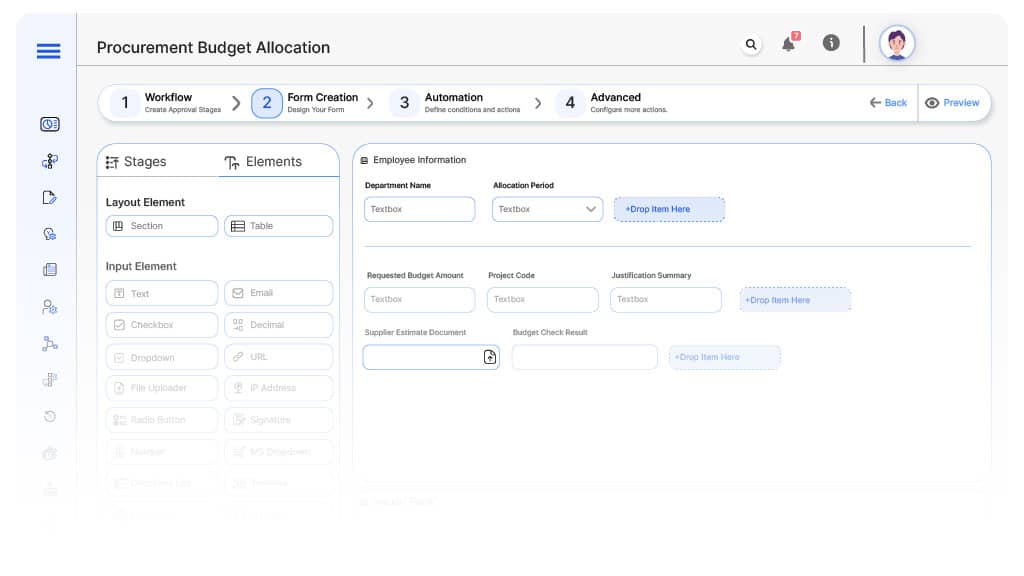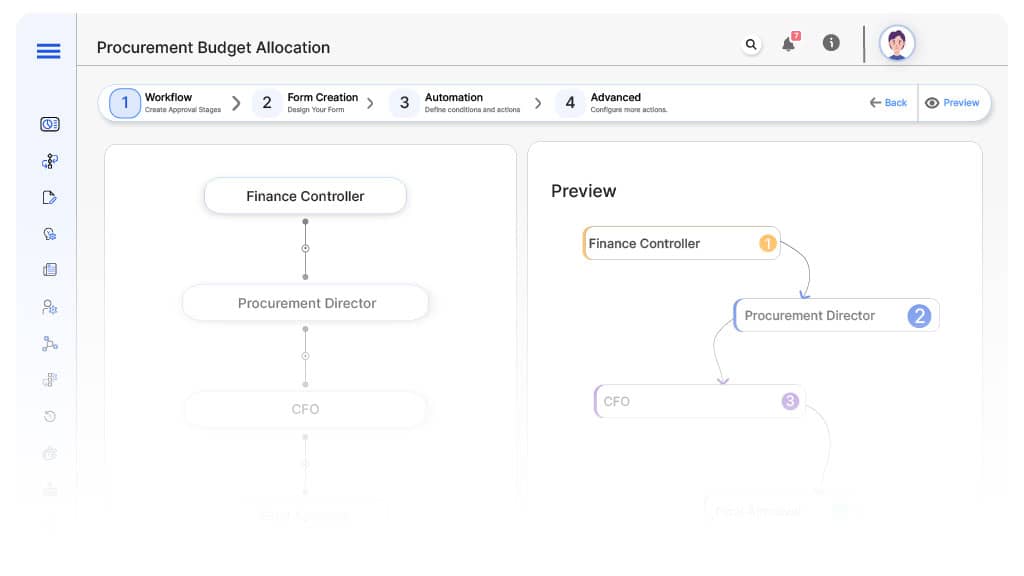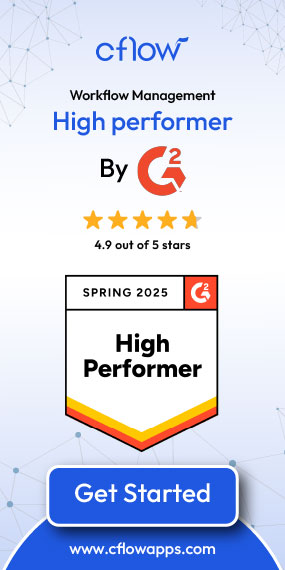- Cflow
- Procurement Budget Allocation Automation
Procurement Budget Allocation Automation
Learn how Cflow streamlines Procurement Budget Allocation Process for procurement, finance, and leadership teams, step-by-step workflow, roles, form fields, approval logic, and real examples

Clow Team

Procurement budget allocation ensures departments receive proper financial resources for sourcing activities while staying within company-wide spending limits. Without automation, manual budget allocation leads to misaligned budgets, overcommitments, delays, and financial disputes. Recent industry research shows that 58% of procurement teams struggle with real-time budget visibility due to manual allocation processes.
Without automation, procurement officers, department heads, finance controllers, and CFOs struggle to allocate funds accurately, monitor spending, adjust allocations, and maintain audit trails. This guide walks you through exactly how Cflow automates Procurement Budget Allocation Process, from budget request submission to final allocation approval.
What Is Procurement Budget Allocation Process?
The Procurement Budget Allocation Process governs how departments request, adjust, and receive procurement budgets based on project needs, business forecasts, and company-wide financial planning while ensuring full compliance and spending discipline.
Think of budget allocation as setting the guardrails for procurement teams , every request requires need justification, financial validation, multi-level approval, and audit trail maintenance.
Recent industry research shows that automating procurement budget allocation improves budget utilization by 62% and reduces overspending incidents by 70%.
Why Procurement Budget Allocation Matters for Organizations
Spending Control
Forecast Accuracy
Risk Mitigation
Audit Trail
Try Cflow for free, no credit card needed
Key Benefits of Automating Procurement Budget Allocation with Cflow
- Centralized Budget Request Portal : Cflow allows departments to submit procurement budget requests with cost justifications, project codes, and supplier forecasts into a single system for full transparency.
- Dynamic Routing Based on Allocation Amount : Cflow applies routing rules based on requested budget size, department, and project sensitivity for appropriate review.
- Multi-Level Approval Workflows : Requests route through department heads, finance controllers, CFOs, and executive leadership based on allocation levels.
- Real-Time Notifications & Escalations : Automated alerts ensure timely reviews while escalation rules prevent allocation delays.
- Budget Policy Validation : Cflow checks against available financial plans, previous allocations, and approved procurement pipelines to avoid over-allocations.
- Full Audit Trail & Allocation History : Every request, approval, adjustment, and allocation change is archived for financial reporting and audit compliance.
- Mobile Accessibility : Department managers, finance controllers, and executives can review and approve allocation requests remotely.
Get the best value for money with Cflow
User Roles & Permissions
Department Manager (Initiator)
- Responsibilities: Submit procurement budget requests with justification, project codes, and supplier estimates.
- Cflow Permission Level: Submit Form.
- Mapping: “Department Group.”
Finance Controller
- Responsibilities: Validate financial availability, check budget overlaps, and verify funding codes.
- Cflow Permission Level: Approve/Reject.
- Mapping: “Finance Team.”
Compliance Officer
- Responsibilities: Confirm procurement feasibility, supplier commitments, and alignment with sourcing strategy.
- Cflow Permission Level: Approve/Reject.
- Mapping: “Procurement Team.”
CFO (Conditional)
- Responsibilities: Final sign-off for high-value or strategic allocation requests.
- Cflow Permission Level: Approve/Reject.
- Mapping: “CFO Group.”
Executive Leadership (Conditional)
- Responsibilities: Ultimate approval for large or cross-departmental budget shifts.
- Cflow Permission Level: Approve/Reject.
- Mapping: “Executive Board.”
Discover why teams choose Cflow
Form Design & Field Definitions

Field Label: Budget Allocation Request ID
- Type: Autonumber
- Auto-Populate: Generated on submission.
Field Label: Department Name
- Type: Dropdown
- Logic/Rules: Mandatory.
Field Label: Allocation Period
- Type: Date Range Picker
- Logic/Rules: Mandatory.
Field Label: Requested Budget Amount
- Type: Numeric Field
- Logic/Rules: Drives routing.
Field Label: Project Code
- Type: Dropdown
- Logic/Rules: Mandatory.
Field Label: Justification Summary
- Type: Text Area
- Logic/Rules: Mandatory.
Field Label: Supplier Estimate Document
- Type: File Upload
- Logic/Rules: Optional; required for large requests
Field Label: Budget Check Result
- Type: System Flag
- Logic/Rules: Policy-driven.
Field Label: Finance Review Notes
- Type: Text Area
- Logic/Rules: Required for finance controller.
Field Label: Procurement Review Notes
- Type: Text Area
- Logic/Rules: Required for procurement director.
Field Label: CFO Comments
- Type: Text Area
- Logic/Rules: Required for CFO.
Field Label: Executive Comments
- Type: Text Area
- Logic/Rules: Required for executive board.
Field Label: Allocation Confirmation
- Type: Checkbox
- Logic/Rules: Finance marks allocation finalized.
Field Label: Executive Comments
- Type: Text Area
- Logic/Rules: Required for executive approval.
Transform your Workflow with AI fusion
Approval Flow & Routing Logic

Submission → Finance Controller
- Status Name: Pending Finance Review
- Notification Template: “Hi Finance, procurement budget request submitted for review.”
- On Approve: Moves to Procurement Director.
- On Reject: Returns to Department Manager.
- Escalation: Reminder after 1 day.
Finance → Procurement Director
- Status Name: Pending Procurement Review
- Notification Template: “Hi Procurement, budget request requires sourcing validation.”
- On Approve: Moves to CFO (if applicable).
- On Reject: Returns to Finance Controller.
- Escalation: Reminder after 1 day.
Procurement → CFO (Conditional)
- Status Name: Pending CFO Approval
- Notification Template: “Hi CFO, high-value allocation request requires final approval.”
- On Approve: Moves to Executive (if applicable).
- On Reject: Returns to Procurement Director.
- Escalation: Reminder after 1 day.
CFO → Executive Leadership (Conditional)
- Status Name: Pending Executive Board Approval
- Notification Template: “Hi Board, strategic procurement budget request requires final sign-off.”
- On Approve: Moves to Allocation Authorized.
- On Reject: Returns to CFO.
- Escalation: Reminder after 1 day.
Final → Allocation Authorized
- Status Name: Budget Allocation Approved
- Notification Template: “Procurement budget fully authorized and funds allocated.”
Transform your AI-powered approvals
Implementation Steps in Cflow
Create a new workflow
Design the form
Set up User Roles/Groups
Build the process flow diagram
Configure notifications
Set conditional logic
Save and publish workflow
Test with a sample request
Adjust logic if needed
Go live
Example Journey: Marketing Procurement Allocation
FAQ's
Setup typically completes within 5–7 business days.
Unleash the full potential of your AI-powered Workflow

